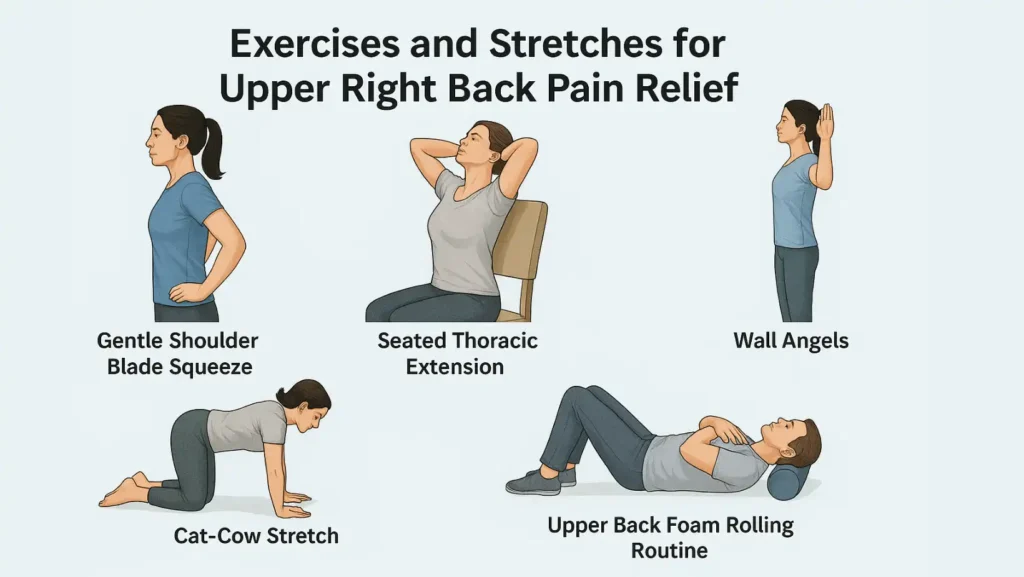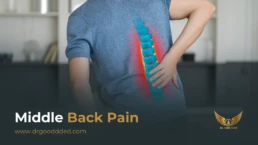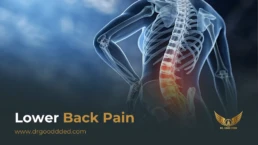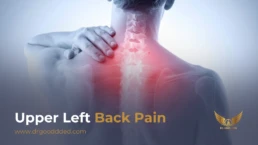Upper right back pain is one of the most common discomforts people experience in daily life. The pain can range from a mild ache after sitting too long to sharp stabs that make breathing or moving the arm difficult.
Table of Contents
ToggleMost of the time, the cause is not life-threatening. Muscle strain, poor posture, and joint stiffness explain most cases. But sometimes the pain signals something more serious, like nerve problems, gallbladder disease, or lung conditions.
Why Does My Upper Right Back Hurt – And What Can I Do About It?
The upper back, or thoracic spine (part of the backbone), stretches from the base of the neck to the bottom of the ribcage. The bones (vertebrae), discs, ribs, muscles, ligaments, and nerves all work together to keep you stable and mobile. When one part is stressed, the whole area can ache.
Upper right back pain often feels different from lower back pain. Since this part of the spine is attached to the ribs, pain may spread to the chest or shoulder blades. Unlike lower back pain, which is usually caused by lifting, upper back pain is often related to posture, repetitive movements, or stress.
For example, a gallbladder problem may cause pain under the right shoulder blade, while a lung infection may hurt when you take a deep breath. That is why a correct diagnosis is important.
The first step is to pay attention to the pattern of pain. If it improves with movement and heat, it is usually muscular. If it comes with shortness of breath, chest pain, fever, or nausea, urgent medical attention is needed.
Common Causes Of Pain In The Upper Right Back

Muscle Strain And Overuse Injuries
The most frequent cause of upper right back pain is a simple strain. This happens after lifting heavy objects, sitting at a computer for long hours, or sleeping in an awkward position. The pain usually feels tight and sore, and the area may be tender to touch.
A person who spends hours typing without support may strain the muscles between the shoulder blades. The pain feels sore, stiff, or like a pulling sensation. Rest, heat, and gentle stretching usually help.
Herniated Disc Or Nerve Compression
Between each bone in the spine sits a disc that cushions movement. If one bulges or herniates, it can press on a nerve. This causes sharp, shooting pain that may travel around the ribs or chest. You may also feel tingling or numbness. While not as common in the thoracic spine as in the neck or lower back, it can still happen, especially after injury.
Osteoarthritis And Spinal Degeneration
With age or long-term stress on the spine, the joints may wear down. This is called osteoarthritis. The joints become stiff, leading to aching pain that feels worse in the morning or after sitting for a long time. Over time, degeneration (wear and tear) of the spine can also limit flexibility.
Myofascial Pain Syndrome (MPS)
Myofascial pain syndrome happens when trigger points, also called “knots,” form in the muscles. Pressing on these points causes pain that can spread under the shoulder blade or across the back. Myofascial pain often comes from repetitive strain, bad posture, or stress.
Stress And Muscle Tightness
Stress and emotional tension make the shoulder and back muscles contract. Over time, this creates aching pain, especially in the right upper back if you tend to favor that side. Stress management, breathing exercises, and posture breaks often help.
Recognizing Symptoms Of Upper Right Back Pain
Sharp Vs Dull Pain Patterns
A dull, aching pain usually suggests muscle strain or joint overload. Sharp or electric-like pain may point to a nerve problem. If the pain stays the same even when resting or comes with fever and night sweats, you should see a doctor.
Pain Under The Right Shoulder Blade
Many people with upper right back pain feel it just under the shoulder blade. This can be from muscle strain, poor posture, or even gallbladder problems. If the pain appears with nausea or stomach pain after meals, it may be organ-related.
Pain When Breathing Or Moving The Arm
If the pain worsens when you take a deep breath, it might be linked to the lungs or the lining of the chest (pleura). Shoulder injuries like bursitis may also hurt when moving the arm above the head.
Associated Symptoms
Other signs that matter include:
- Fever and cough, which may mean pneumonia.
- Rash on one side, which could be shingles.
- Sudden shortness of breath and chest pain which can mean a blood clot in the lungs.
These require medical care right away.
Diagnosis – How Doctors Identify The Cause
Physical Examination And Posture Assessment
The doctor will check posture, shoulder blade motion, muscle strength, and tender points. They may ask you to move your arms and take deep breaths to see if the pain changes.
Imaging Tests
Scans are not always needed at first. But if pain continues or serious symptoms appear, doctors may order tests.
- X-rays show bones and joints.
- MRI shows discs, nerves, and soft tissues.
- CT scans give more detail on bones.
When To Visit A Specialist
You should see a specialist if your pain does not improve after rest, stretching, or home remedies. If you feel numbness, tingling, or weakness in your arm, chest, or back, you should consider reaching out to a specialist.
- If your pain seems linked to bones, discs, or joints, you should check with an orthopedic doctor who can help in this case.
- If you notice breathing-related pain, cough, or fever, a pulmonologist may need to check your lungs.
- If your pain comes after eating fatty foods and is paired with nausea or vomiting, you should consult with a gastroenterologist for gallbladder or liver issues.
Effective Treatment Options For Right upper back pain
Home Remedies For Mild Pain
- Apply a heating pad for 15 minutes.
- Use gentle stretching twice daily.
- Over-the-counter medicines like ibuprofen or acetaminophen may help.
- Rest for one to two days, but avoid staying in bed for too long.
Medical Treatments
When home remedies are not enough, doctors may step in with targeted medical care:
- Prescription medicines : Doctors often prescribe stronger anti-inflammatory drugs or muscle relaxants when pain flares up and home remedies fail.
- Physical therapy : A physical therapist designs exercises to strengthen the spine, correct posture, and reduce recurring pain. They may use ultrasound therapy, electrical stimulation, or manual therapy.
- Trigger point injections : Doctors inject anesthetic or saline directly into muscle knots to relieve myofascial pain syndrome.
- Steroid injections : Doctors use steroid shots to calm inflammation from arthritis or irritated discs. Relief can last for weeks or months.
Lifestyle Modifications
Small daily changes help more than strong medicines. These include adjusting your chair and desk height, taking breaks every 30 minutes, and sleeping with proper support under your neck and shoulders.
Advanced Treatments (For Chronic Cases)
If pain lasts for months and interferes with daily life, advanced options may be considered:
- Minimally invasive surgery : Surgeons remove or stabilize herniated thoracic discs if they press on nerves. They recommend surgery only when other treatments fail.
- Radiofrequency ablation : In cases of facet joint pain, doctors use heat to disrupt pain signals from nerves.
- Spinal injections : Doctors inject medicine into the epidural space or around nerves to reduce chronic pain.
- Multidisciplinary pain management : Specialists combine medication, therapy, counseling, and lifestyle changes into one program for long-term pain relief.
Exercises And Stretches For Upper Right Back Pain Relief

Gentle Shoulder Blade Squeeze
- Sit or stand tall with arms at your sides.
- Slowly squeeze your shoulder blades together as if you’re tucking them into your back pockets.
- Hold for 5 seconds, then relax. Repeat 10–12 times.
This strengthens the rhomboid and trapezius muscles, which often become weak from poor posture.
Seated Thoracic Extension
- Sit in a sturdy chair with a backrest at mid-spine level.
- Place your hands behind your head.
- Lean your upper back over the chair edge while keeping your lower back stable.
- Hold for 5 seconds, then return. Repeat 8–10 times.
This opens the chest, stretches tight muscles, and mobilizes stiff vertebrae.
Cat-Cow Stretch
- Start on your hands and knees.
- As you exhale, round your spine upward like a cat.
- As you inhale, lower your belly and lift your chest.
- Continue for 10 slow breaths.
This yoga-inspired move keeps the thoracic spine flexible and reduces stiffness.
Wall Angels
- Stand with your back against a wall, feet slightly forward.
- Keep your lower back pressed gently into the wall.
- Slowly raise your arms up and down like making a snow angel.
- Perform for 1–2 minutes.
This trains the shoulder stabilizers and improves posture, reducing strain in the upper right back.
Upper Back Foam Rolling Routine
- Lie on your back with a foam roller placed horizontally under the shoulder blades.
- Cross your arms across your chest or support your head.
- Roll slowly up and down the upper back for 1–2 minutes.
- Pause on tight spots and breathe deeply.
Foam rolling helps release muscle knots and improves blood flow to stiff tissues.
Prevention Tips – Keep Upper Right Back Pain Away
Maintain Good Posture At Work And Sleep
Slouching at a desk or sleeping in odd positions is a major cause of pain. Sit upright with your shoulders relaxed and screen at eye level. When sleeping, use a pillow that keeps your head aligned with your spine. Side sleepers may benefit from hugging a pillow for extra support.
Strengthen Core And Shoulder Muscles
Weak core and shoulder muscles make the spine work harder. Adding bodyweight exercises like planks, band rows, and wall push-ups two to three times per week helps build support. Strong muscles act like armor for the upper back.
Stay Active And Stretch Daily
Motion keeps joints lubricated and muscles flexible. A 20–30 minute walk, cycling, or light swimming most days prevents stiffness. Adding 5 minutes of stretches at the end of the day relaxes the upper back and improves circulation.
Manage Stress And Avoid Long Sitting Hours
Stress causes unconscious shoulder hunching. Combine stress relief with posture breaks. For example, set an alarm to stand up every 30 minutes, stretch your arms overhead, and take 5 deep breaths. This simple routine lowers tension and prevents stiffness.
FAQs
How to relieve upper right side back pain?
Use heat, gentle stretches, and over-the-counter medicines if needed. If pain lasts more than two weeks or worsens, see a doctor.
When should I worry about upper right back pain?
Seek urgent care if you have chest pain, breathing trouble, fever, rash, numbness, or sudden severe pain. These can signal serious conditions.
What causes pain in the upper right back?
Causes include muscle strain, poor posture, arthritis, disc problems, or organ issues such as gallbladder disease or lung infection.
Why is upper back pain a red flag?
Because it can point to heart, lung, or gallbladder problems. Pain linked with breath changes, chest pain, or fever is always a warning.
How do I know if my back pain is muscle or organ?
Muscle pain worsens with movement and eases with rest. Organ pain often feels deep and steady and may come with nausea or fever.
What vitamin deficiency causes back pain?
Low vitamin D can cause bone pain and weak muscles. Testing is needed before taking supplements.
When not to ignore upper right back pain?
Do not ignore pain that spreads, is severe, or comes with new symptoms like weakness, cough, or fever. These require medical attention.
Also read:
Upper Left Back Pain: Causes, Symptoms, and Effective Treatment Options
6 Tips for Better Posture and Spinal Health
Home Remedies for Body Pain: Effective Natural Solutions
Home Remedies for Arthritis: Natural Solutions for Joint Pain

This article is medically reviewed by Dr. Chandril Chugh, Board-Certified Neurologist, providing expert insights and reliable health information.
Dr. Chandril Chugh is a U.S.-trained neurologist with over a decade of experience. Known for his compassionate care, he specializes in treating neurological conditions such as migraines, epilepsy, and Parkinson’s disease. Dr. Chugh is highly regarded for his patient-centered approach and dedication to providing personalized care.








